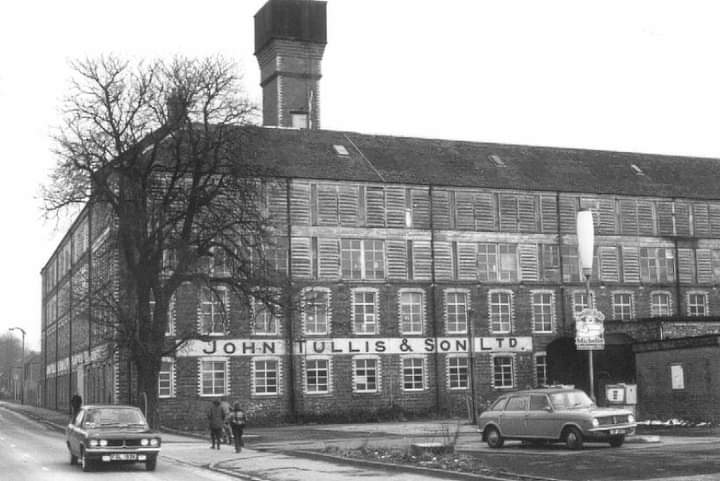Tullibody, like most settlements in Clackmannanshire, is a former mining town. In the past as now, many of the residents needed to commute to and from their place of work, be it in Alloa, Stirling or further afield. Currently Tullibody boasts a population of almost 9,000.
Historically, there was work locally with wool, farming and a tannery and bone works on Alloa Road, which processed leather and made glue.
The tannery at Tullibody was once an employer of note in the village, as incongruous to their surroundings as the later tannery buildings were. The original buildings on the tannery site were run by the Paterson family. Alexander Paterson was a shoemaker who expanded into small-scale tanning. His son, also Alexander, began a full-scale tanwork at the tannery site in 1806, using the bark tanning (vegetable tanning) process. The adjoining bone works made glue and bone meal fertilizer.
The Patersons were able to profit from their business and had Baingle Brae House in Tullibody constructed by 1834.

Baingle Brae House - Pic from Facebook
This house and its attached gardens were demolished and replaced by social housing in the 1960s.
By the 1840s the tannery business had a total of 30 to 40 employees. Alexander Paterson (junior), died on 31st December 1866, his sons John and Andrew then ran the business. The tannery business declined for some years, with the bone works continuing until the death of John Paterson on 3rd May 1888.
In 1889, the tannery and bone works were sold for £800 to John Kennedy, an agent for the Tullis family of Glasgow, and by 1891 the proprietor of the site is registered as John Tullis & Son, leather manufacturer. The tannery experienced a time of rising fortunes again, with many changes being made to the site. After complaints from local farmers that a stream was being polluted by the Tullis company's operations, the local council got involved and forced the tannery to make changes to the works. By early 1892 the company had responded to a call from the authority to install cesspools, something which resulted in an improvement to the sewage problem. Filters for settling tanks were added the following year, although complaints continued.
By this time the main building consisted of a large four storey and attic building, of red and white brick structure, on an L plan, with louvered ventilators in the top two floors. In the angle formed by the L was a shorter building and a single storey workshop, with prominent roof ridge ventilators, and at the rear was a detached four storey boiler house, with a circular section brick chimney. There was also a tall brick water tower.
John Kennedy and Robert Ramsay Tullis were the first managers of the enlarged tannery, which dealt with hides from the Highlands and those imported through east coast ports. The building-up of the Tullibody tannery had been part of a general expansion by John Tullis & Son, which saw its hide-processing capacity increase from 2000 in 1880 to 4000 in 1900. By 1900, 2000 hides a week were processed at Glasgow and 1000 at the company's other tanneries in Tullibody and Warrington. Tullibody had easy railway access to Glasgow and beyond via the railway station at Cambus.
A proportion of the Tullibody hides went to other manufacturers, but a substantial number were destined for the company owned St. Ann's Works in the East End of Glasgow. This plant produced leather-edged cotton belting for industrial purposes as well as being a tannery in its own right.
As late as 1951 the tannery remained the second largest employer in the locality, by this time having a staff of around 85. Cambus whisky distillery, the largest nearby employer, had a staff of 120.
In December 1959, John Tullis and Sons were taken over by Howard Glasgow Association on behalf of James Glasgow. Quite soon after the tannery was closed and most of the workers were laid off. It had been thought uneconomical to replace the equipment in the tannery, which was by then regarded as obsolete.
After the tannery ceased operations, it was converted into a plastics factory, run by John Tullis (Plastics) Ltd, making plastic hoses. Many of the ancillary buildings became unused surplus and were not maintained. When the plastics factory closed the buildings were in a poor state and unlikely to find a new tenant. John Tullis (Plastics) Ltd sold the factory and associated land to the council for £2 in 1991. During the demolition of the site which began in July 2001, some areas were cleared and checked for Anthrax and chemical contamination. Anthrax can be found at very low concentration in some grazing animals, and it was thought that there might be areas from the defunct tanning operation that possibly could have Anthrax and other harmful chemicals within the soil.

1970s photo of the Tullibody Tannery Building and part of the next-door petrol station - internet photo
The neighbouring petrol filling station had been demolished and the land cleared for new housing, building of which started in 2014. The cleared tannery land was integrated as a phase 2 build, which completed in August 2018.
References:
More information can be found here: Tannery Demolition (angelfire.com)
